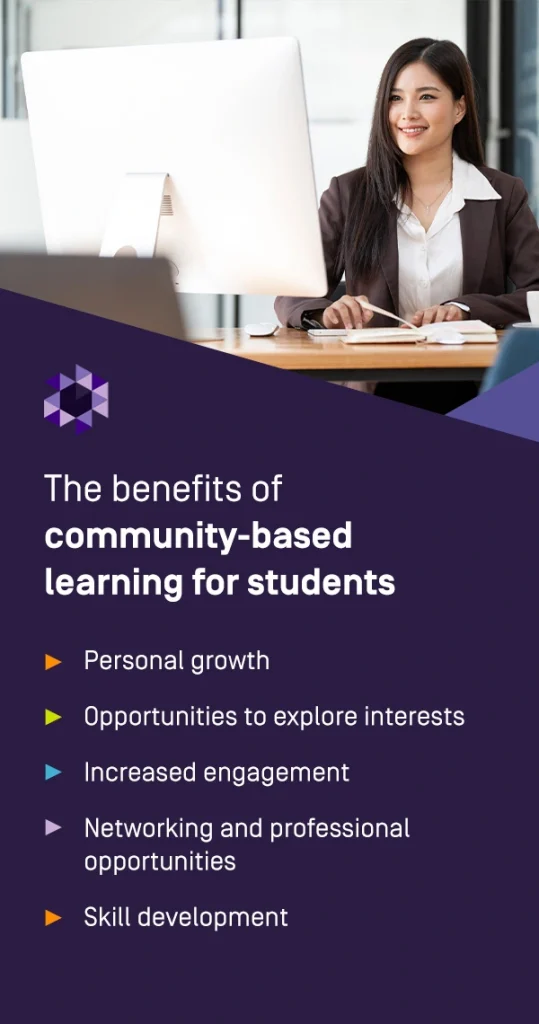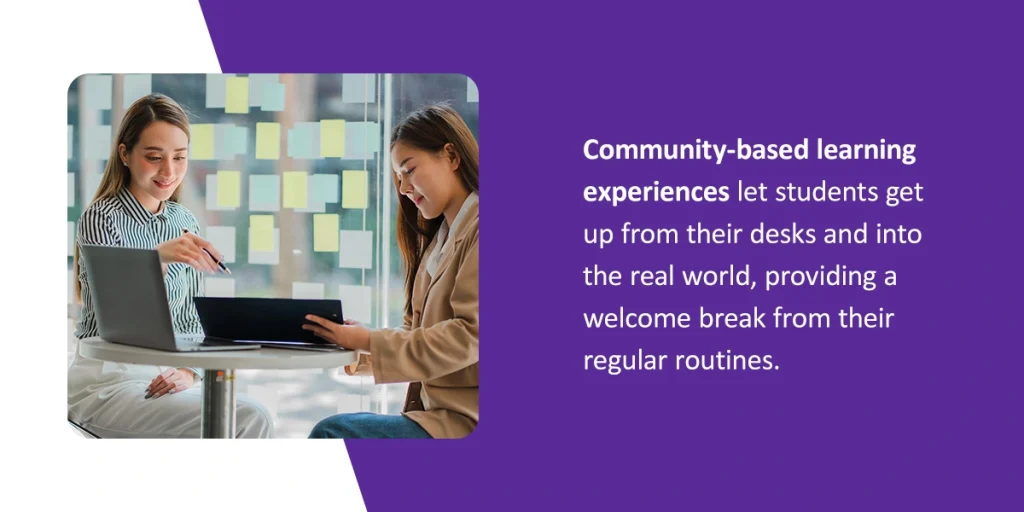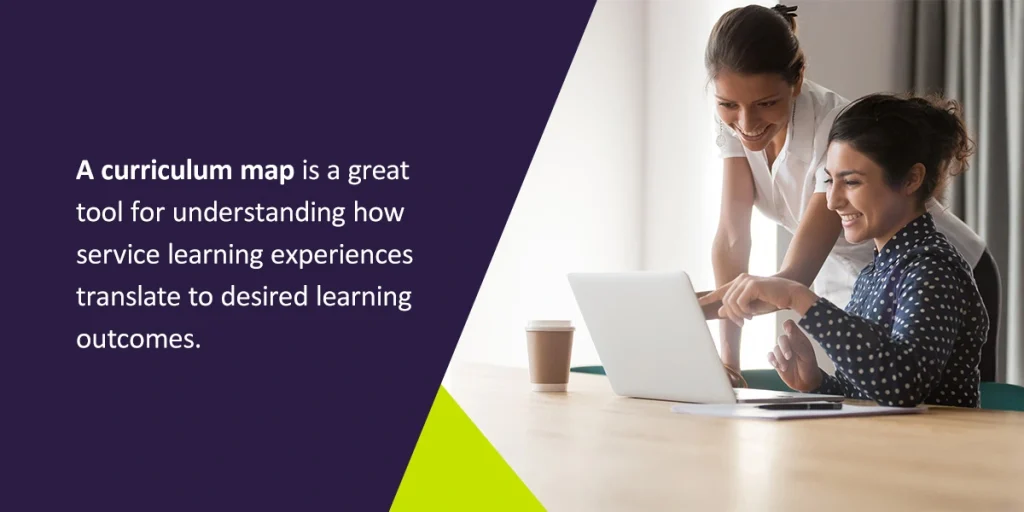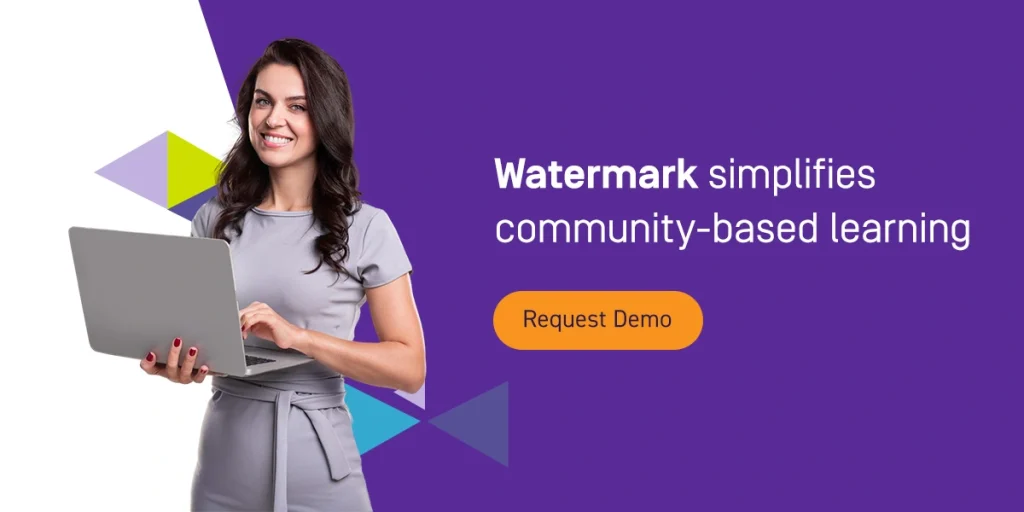
Experiential learning, or “learning by doing,” is a growing trend in higher education that gives students the opportunity to apply their knowledge to situations outside the classroom. For many students, a hands-on course gives them the opportunity to test out their intended career path and build new relationships while practicing the critical skills they’re learning in their studies.
Community-based learning is an excellent example. Offering opportunities for community-based learning can help your students engage more with their classes and develop critical life skills — and in the long run, it can help your institution stand out as a leader in your region.
What is community-based learning?
Although community-based learning is simple by definition, it comes with many moving parts.
Also known as community engagement or service learning, community-based learning is an experiential learning practice that combines community service with academics to benefit both students and the general public.
We can break community-based learning into four distinct types:
- Direct: Students work on projects that directly impact the people they are serving.
- Indirect: Students work on projects that benefit the community as a whole.
- Research-based: Students gather information on areas of interest that can benefit the community and incorporate that information into a project.
- Advocacy: Students focus on projects that raise awareness about issues that impact the local community.
Service learning courses can come in many different forms depending on the type of service and the academic subject. For example, some institutions allow students to add community service credits to classroom-based courses they plan to take as part of a cocurricular activity.
Students might follow a hybrid schedule, where they split their time between the field and the classroom. Or they may not meet in the classroom at all, spending all the course hours in the field either independently or with their classmates. In some cases, students might be able to work one-on-one with an academic advisor to create a personalized course that fits their unique schedule and career goals.
Regardless of the format, service learning courses typically require students to meet periodically with their instructor or mentor to discuss their experiences and progress. These meetings help ensure students stay on track and hold them accountable for completing their work on time.
Community-based learning examples
Any course that involves a community service element is an example of community-based learning. And that community service element can involve almost any activity that enables students to help the local community.
For example, students in a service learning course might:
- Teach music lessons to children in underserved communities.
- Remove invasive plants from local parks.
- Restore historic monuments and buildings.
- Study pollution in local bodies of water.
- Create marketing materials for nonprofits.
- Assist in teaching courses to incarcerated people.
- Volunteering in administrative roles at local hospitals.
If your institution is considering implementing service learning, the above community-based learning ideas can serve as a good jumping-off point for course offerings. It can also help to assess what competing institutions are doing, as their courses can provide a frame of reference for what works and what doesn’t.
The benefits of community-based learning for students

While community-based learning directly helps your local community, it can also make a huge impact on your students. Some of the biggest community-based learning benefits for students include:
- Personal growth: Community engagement through service learning allows students to interact with diverse populations, giving them the chance to develop vital interpersonal skills and build self-confidence.
- Opportunities to explore interests: Experiential learning courses give students the chance to reaffirm their interest in their chosen course of study. It also enables them to explore new interests they may not have previously considered.
- Increased engagement: When students see how they can use the skills they’re learning to directly impact the community, they’re more likely to engage with their studies.
- Networking and professional opportunities: Service learning expands the student’s network of professional contacts, which can help them later when they begin applying for jobs after graduation.
- Skill development: Service learning lets students broaden their skill set beyond what’s possible to teach in the classroom. For example, while your institution may lack access to certain enterprise tech tools, your community partners might give students the chance to use software they could encounter later in their careers.
The benefits of service learning extend beyond students, too. Faculty can use field experiences as tools to guide lesson plans throughout the semester, allowing for a more dynamic course that changes to reflect evolving student needs.
3 ways community-based learning can improve student success rates
While higher education enrollment rates rose in 2022, they’re still significantly lower than they were in 2019. Applying a greater focus on retaining existing students will be more important than ever moving forward, which is why institutions need to make sure they’re setting their students up for success.
In today’s higher education landscape, student success involves more than high test scores and graduation rates. It’s a holistic measure of student wellness and achievement that naturally includes social well-being — and community involvement can be an excellent component.
1. Translating classroom learning into action
It’s easy for students to tune out when they can’t see how what they learn in the lecture hall benefits them — or their communities. Community-based learning gives them the chance to make their own connections between course content and the real world, which allows them to take ownership of their learning and find new ways to apply their knowledge.
It also grants the ability to make their own decisions and take risks in real-world scenarios, which can make them feel more motivated to learn and engage more with course content. Students who are looking to get real-world experience and class credit at the same time will benefit significantly from this arrangement.
2. Exposing students to new experiences

The traditional classroom setting isn’t for everyone. Most students need some kind of variety in their education to keep them motivated — that’s why personalized learning initiatives are becoming so popular in higher education institutions.
Community-based learning experiences let students get up from their desks and into the real world, providing a welcome break from their regular routines. This change can help reinvigorate interest in students who may feel disconnected from their studies.
These programs also let students explore new environments and perspectives, which helps them fight bias and develop a more well-rounded view of the world. That said, program leaders need to be careful not to reinforce stereotypes about the people students are serving during the course. Providing opportunities for direct service, even if most of the course requires another type, can reduce this risk by requiring students to work face-to-face with the real people they are serving.
3. Building new relationships
Establishing a strong sense of belonging is essential for student success, but commuters and other non-traditional students often struggle to find their place on campus. And most lecture-based classes provide only limited opportunities to develop rapport with other students.
Service learning courses provide opportunities for students to connect more deeply with their peers and the greater community, which can help them build the self-confidence they need to find their place at your institution. Working together on projects outside of the classroom provides a more natural setting for classmates to get to know each other, and field service lets them forge connections with community leaders and professionals in their field.
Additionally, students in most service learning courses work one-on-one with a mentor or advisor who helps them get the most out of their experience. Students can lean on their mentors to help them find new connections and grow their networks, which can help improve their chances of success long after the class finishes.
5 community-based learning best practices
Strong community-based learning programs can provide students with unforgettable experiences and help them connect more with their education. Designing these programs can be a complex process with lots of moving parts. Finding ways to streamline course planning and management can help significantly.
These helpful tips can provide some guidance on implementing or improving community-based learning in your institution.
1. Choose the right community partners
A high-quality service learning program is only possible when you can build solid relationships with the right organizations. Understanding the community, its history, and its needs can help you pinpoint the best place to start.
You can also find potential partners through online resources like GuideStar, which provides up-to-date information such as mission statements, contact details, and more for local nonprofits. Create a shortlist and reach out to the organizations that make the most sense for the course you’re planning.
It’s also important to consider the existing relationship between your institution and the greater community. Does the community trust your institution? Have you already established a legacy of service and positive cooperation? Consider how this history will affect your relationship when approaching potential partners.
2. Clearly align experiences to learning outcomes

Why are students learning the material you’re teaching them? Without a solid answer, it’s significantly more challenging to keep students engaged — which can negatively impact their chances of success.
That’s why service learning courses should have a defined purpose, just like every other course your institution offers. Although community service is never a bad thing, you need to clearly articulate how it connects back to the theoretical content students learn in class. Otherwise, it’s easy for the course to become disjointed and lose its central community-based learning meaning.
A curriculum map is a great tool for understanding how service learning experiences translate to desired learning outcomes. Curriculum maps provide timelines for when students should achieve specific outcomes over the course of their programs, as well as which courses satisfy those requirements.
3. Be flexible with students
Higher education students have chaotic schedules — it’s just part of the experience. That also goes for faculty, who frequently have to balance multiple course sections with their own research and extracurricular duties.
Offering flexible scheduling options for service learning courses can improve each student’s chances of success by making it easier for them to fit their service hours into their schedules. Asynchronous online classes are a great example. Instructors can hold lectures over Zoom, and students can complete their service tasks on their own time. They can then submit reflections, coursework, and proof of their attendance through your learning management system (LMS) for credit.
Or, for a synchronous in-person class, an instructor could break up the in-class portion and the service portion into two parts, providing multiple times students could show up to the service site.
4. Maintain academic rigor
Although the service component of community-based learning gets the most attention, faculty should avoid the temptation to make coursework less demanding.
Mastering academic coursework is just as important in service learning courses as it is in traditional courses. In fact, because it forms the backbone for what students do in their service projects, it’s arguably more important.
Implementing good assessment practices is essential for creating a rigorous community-based learning program. Where we assess traditional course outcomes based on measures like test scores, class discussion participation, and research, though, service learning often presents an assessment obstacle.
Field placements can be challenging to assess using pen-and-paper systems, which is why a streamlined student learning and licensure software program can help simplify community-based learning. A unified, integrated system provides a centralized hub for all service learning data, including progress assessments, assignment submissions, time logging, and more.
Plus, an ePortfolio feature can empower students by giving them a space to showcase all their experiences and accomplishments throughout the course and the rest of their degree program.
5. Implement a strong student success software system
Because service learning programs have many different moving parts, realizing their benefits is challenging without a robust digital support system in place. AI-powered student success and assessment software can help you monitor student engagement levels and ensure your course delivers the results you want.
Student success software uses predictive analytics to proactively identify students who are at risk of failing or dropping out so their support team can help get them back on track. This capability is especially useful for service learning courses that don’t have regular classroom meetings, as faculty are less likely to notice if students are slipping when they don’t see them in person often.
These programs can also provide helpful recommendations for ways to help struggling students throughout their education, such as scheduling meetings with student success professionals or applying for scholarships to ease the financial burden.
Watermark simplifies community-based learning
Whether your institution already offers service learning courses or you’re considering adding some to your curricula, Watermark’s fully integrated suite of software solutions can make managing these courses easy.
Watermark Student Success & Engagement uses predictive analytics to help higher education institutions improve both engagement and student retention rates. Streamlined attendance tracking capabilities allow students to check in to their service locations via the mobile app, and geolocation features confirm their location.
Watermark Student Learning & Licensure supports outcomes assessments for field placements such as clinicals, internships, educator prep, and service learning courses. With the ability to embed rubrics directly into student work, you can standardize assessments and visualize student progress for streamlined reporting. Plus, ePortfolios give students a great format to collect proof of experience that can set them apart in their chosen fields.
Ready to get started? Request your personalized demo today to see how our solutions can boost student success at your institution.
















































































































































































































































































































































































































